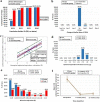Twelve-month outcomes of single-step transepithelial photorefractive keratectomy for moderate hyperopia and hyperopic astigmatism
- PMID: 36855211
- PMCID: PMC9976533
- DOI: 10.1186/s40662-023-00327-4
Twelve-month outcomes of single-step transepithelial photorefractive keratectomy for moderate hyperopia and hyperopic astigmatism
Abstract
Background: Conventional mechanical or alcohol-assisted photorefractive keratectomy (PRK) techniques for correction of hyperopia and hyperopic astigmatism were associated with inconsistent results. The aim of this study is to evaluate the 12-month visual and refractive outcomes of the relatively new single-step transepithelial photorefractive keratectomy (TE-PRK) for moderate hyperopia and hyperopic astigmatism.
Methods: This is a prospective interventional study. Forty-eight eyes of 30 patients with moderate hyperopia or hyperopic astigmatism with a cycloplegic spherical equivalent refraction (SEQ) between 2.0 and 4.5 diopters (D) underwent single-step StreamLight® TE-PRK using EX500 excimer laser (Alcon Laboratories, USA). The main outcome measures were recorded at 6 and 12 months postoperatively including assessment of logarithm of the minimum angle resolution (logMAR) uncorrected and corrected distance visual acuity (UDVA, CDVA), cycloplegic refraction, corneal topographic changes as well as post-PRK peripheral haze grading.
Results: The mean preoperative cycloplegic SEQ was significantly reduced from 3.21 ± 0.61 D to 0.35 ± 0.04 D and 0.41 ± 0.04 D at 6 and 12 months, respectively (P < 0.001). The mean preoperative UDVA significantly improved from 0.53 ± 0.02 logMAR to 0.07 ± 0.01 logMAR and 0.08 ± 0.01 logMAR at 6 and 12 months, respectively (P < 0.001) while the mean preoperative logMAR CDVA showed non-significant change over time throughout the study (P = 0.135). At the end of the study, 41 eyes (85.4%) achieved UDVA of 20/25 or better and no eye lost any lines of CDVA. Thirty-eight eyes (79.1%) had a postoperative cycloplegic cylinder of 0.5 D or less at 12 months. The mean preoperative mean keratometry showed significant increase at 6 and 12 months postoperatively (P < 0.001) while there was no significant change between the two postoperative visits denoting topographic stability (P = 0.058). The mean postoperative Q value at 6 and 12 months showed a significant prolate shift (P < 0.001). No haze was observed in 62.5% and 85.4% of the enrolled eyes at 6 and 12 months, respectively.
Conclusions: Single-step StreamLight® TE-PRK for moderate hyperopia and hyperopic astigmatism achieved acceptable visual and refractive outcomes.
Trial registration: (Clinicaltrials.gov): NCT05261685, 2 March 2022, retrospectively registered, https://clinicaltrials.gov/ct2/show/NCT05261685.
Keywords: Hyperopia; Hyperopic PRK; Hyperopic astigmatism; Single-step PRK; StreamLight PRK.
© 2023. The Author(s).
Conflict of interest statement
The authors declare that they have no competing interests.
Figures




Similar articles
-
Transepithelial Photorefractive Keratectomy for Hyperopia Correction: An Uncharted Territory.Clin Ophthalmol. 2023 May 30;17:1497-1504. doi: 10.2147/OPTH.S415636. eCollection 2023. Clin Ophthalmol. 2023. PMID: 37273504 Free PMC article. Review.
-
StreamLight Single-Step Transepithelial Photorefractive Keratectomy (PRK) for Myopia and Myopic Astigmatism.J Ophthalmol. 2024 Nov 14;2024:5597457. doi: 10.1155/2024/5597457. eCollection 2024. J Ophthalmol. 2024. PMID: 39575318 Free PMC article.
-
Laser-assisted subepithelial keratectomy and photorefractive keratectomy for the correction of hyperopia. Results of a 2-year follow-up.J Cataract Refract Surg. 2003 Nov;29(11):2105-14. doi: 10.1016/s0886-3350(03)00415-2. J Cataract Refract Surg. 2003. PMID: 14670418 Clinical Trial.
-
Transepithelial Photorefractive Keratectomy for Hyperopia: A 12-Month Bicentral Study.J Refract Surg. 2016 Mar;32(3):172-80. doi: 10.3928/1081597X-20160121-01. J Refract Surg. 2016. PMID: 27027624
-
Visual and refractive outcomes of photorefractive keratectomy in hyperopia and hyperopic-astigmatism: A systematic review and meta-analysis.Photodiagnosis Photodyn Ther. 2025 Jun;53:104604. doi: 10.1016/j.pdpdt.2025.104604. Epub 2025 Apr 24. Photodiagnosis Photodyn Ther. 2025. PMID: 40287029
Cited by
-
Nominal and achieved stromal ablation depth after myopic transepithelial photorefractive keratectomy: implications for residual stromal thickness calculation.Eye Vis (Lond). 2024 Sep 2;11(1):36. doi: 10.1186/s40662-024-00404-2. Eye Vis (Lond). 2024. PMID: 39223626 Free PMC article.
-
Transepithelial Photorefractive Keratectomy for Hyperopia Correction: An Uncharted Territory.Clin Ophthalmol. 2023 May 30;17:1497-1504. doi: 10.2147/OPTH.S415636. eCollection 2023. Clin Ophthalmol. 2023. PMID: 37273504 Free PMC article. Review.
-
Efficacy of single-step transepithelial photorefractive keratectomy in myopia, hyperopia and astigmatism-a systematic review.BMC Ophthalmol. 2025 Feb 26;25(1):93. doi: 10.1186/s12886-024-03830-x. BMC Ophthalmol. 2025. PMID: 40001065 Free PMC article.
-
Transepithelial Photorefractive Keratectomy-Review.Vision (Basel). 2024 Mar 21;8(1):16. doi: 10.3390/vision8010016. Vision (Basel). 2024. PMID: 38535765 Free PMC article. Review.
-
StreamLight Single-Step Transepithelial Photorefractive Keratectomy (PRK) for Myopia and Myopic Astigmatism.J Ophthalmol. 2024 Nov 14;2024:5597457. doi: 10.1155/2024/5597457. eCollection 2024. J Ophthalmol. 2024. PMID: 39575318 Free PMC article.
References
Associated data
LinkOut - more resources
Full Text Sources
Medical

